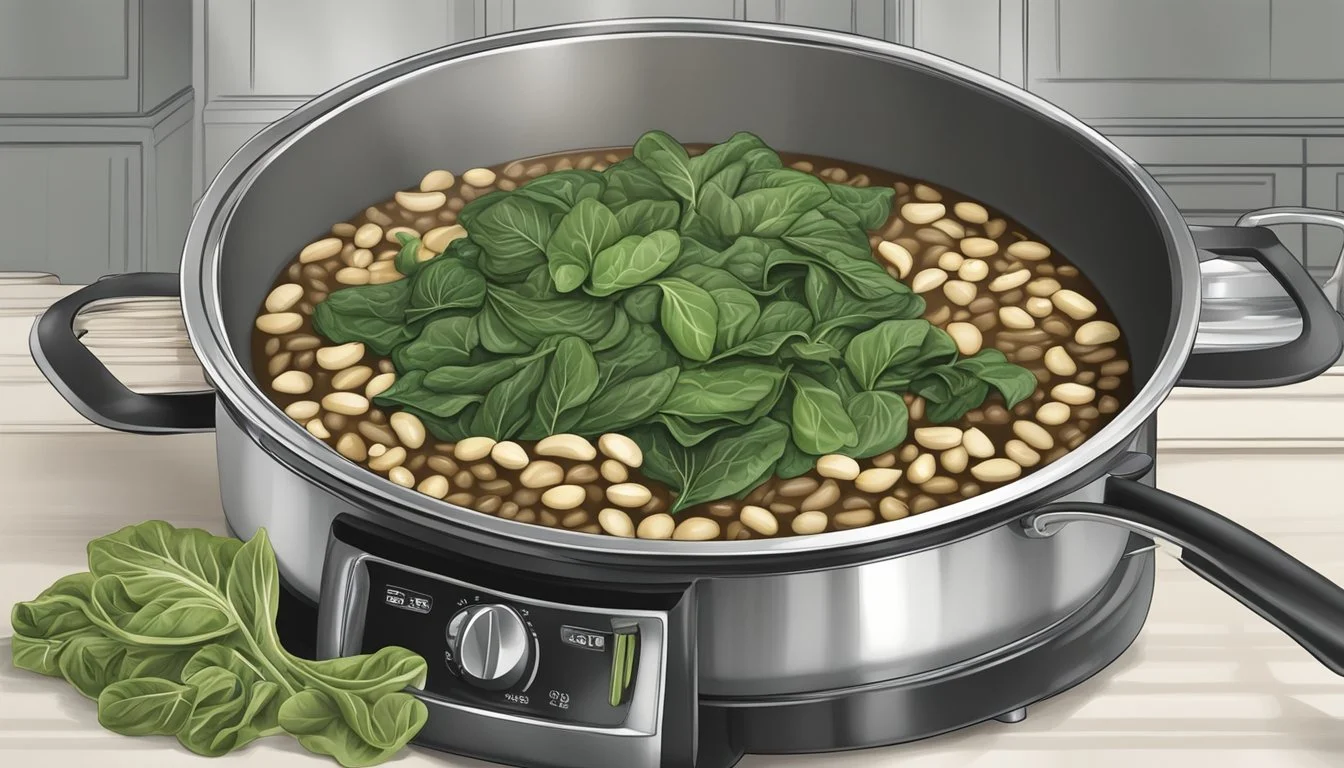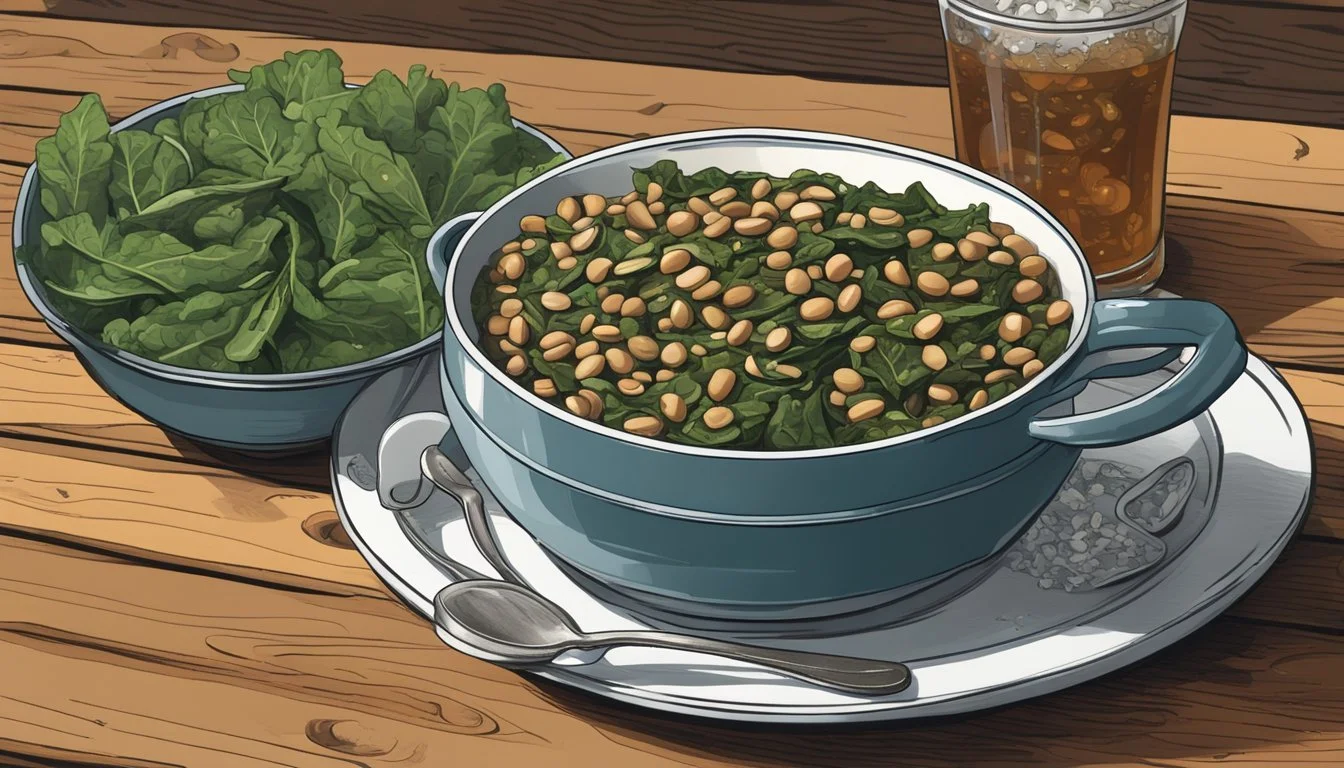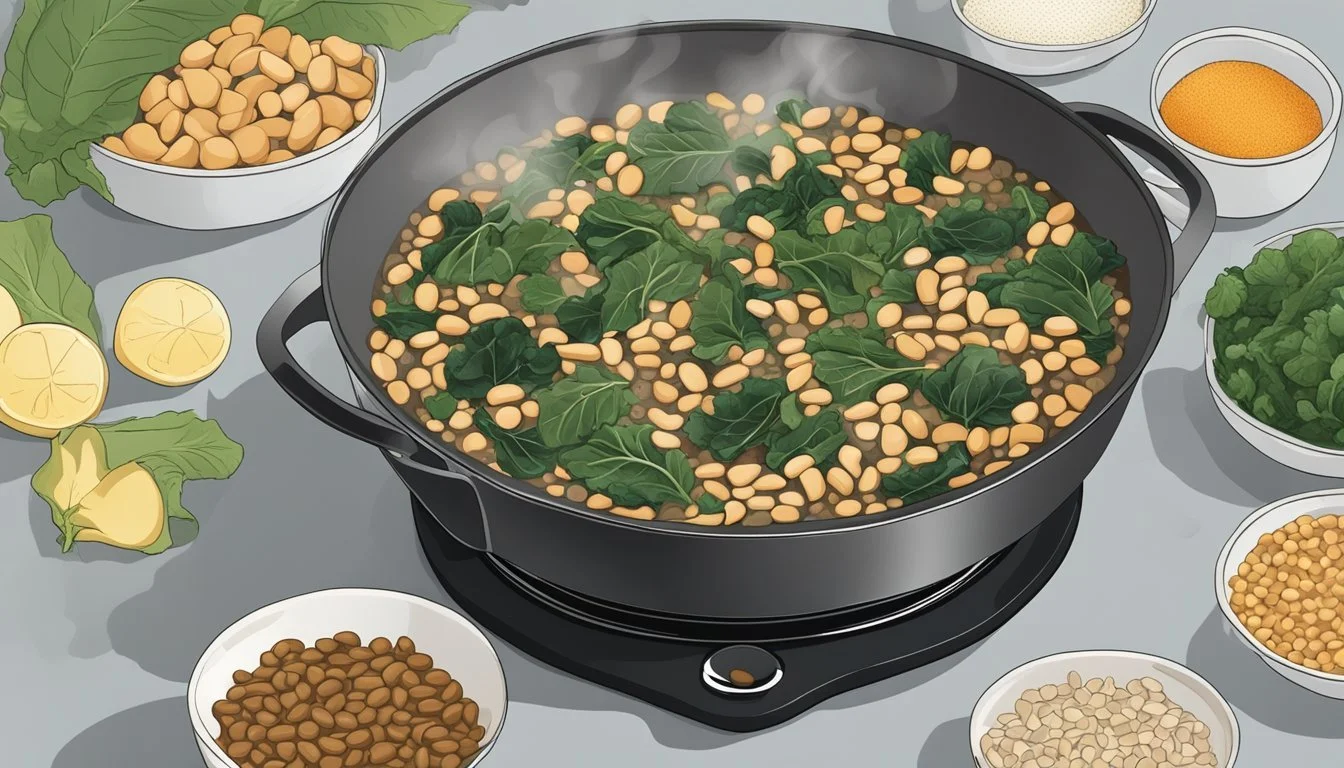How to Reheat Black Eyed Peas and Collard Greens
A Simple Guide
Reheating black-eyed peas and collard greens can be a challenge if you want to maintain their flavor and texture. The best way to reheat these dishes is by using slow, gentle heat to prevent drying out and to allow the flavors to re-meld beautifully. For black-eyed peas, adding a little bit of broth or water during reheating helps maintain their creamy texture and prevents them from becoming too dry.
For collard greens, using a slow cooker or a stovetop with a bit of extra liquid ensures they stay tender and flavorful. Stirring occasionally and adding seasonings can help rejuvenate the dish. This approach not only preserves the texture but also enhances the flavor, making the reheated greens taste as good as freshly cooked.
When reheating, it's crucial to taste and adjust the seasoning. The reheating process can sometimes mute the flavors, so a dash of salt, pepper, or your favorite seasoning can make a big difference. With these tips, your black-eyed peas and collard greens will be just as delicious the second time around.
The Basics of Black Eyed Peas and Collard Greens
Black-eyed peas and collard greens are staples in southern cuisine, featuring prominently in traditional and celebratory meals due to their symbolic and nutritional benefits. These dishes are known for their flavorful combinations and essential nutrients.
Importance in Southern Tradition and Prosperity
In Southern tradition, black-eyed peas and collard greens are often associated with good luck and prosperity, especially when eaten on New Year's Day. This practice is part of soul food culture, where each ingredient has symbolic meaning. Black-eyed peas represent coins, while collard greens symbolize paper money. Together, they are believed to bring wealth in the coming year. This tradition has deep roots in African American heritage and the agrarian history of the Southern United States.
Nutritional Value: Protein, Fiber, Vitamins and Minerals
Black-eyed peas and collard greens are nutritious powerhouses. Black-eyed peas are rich in protein and fiber, making them a hearty addition to any meal. These legumes are also packed with important vitamins and minerals such as folate, potassium, and iron. Collard greens, on the other hand, are an excellent source of vitamins A, C, and K, as well as calcium and iron. The high fiber content in both ingredients aids digestion and promotes overall health.
Common Ingredients and Flavor Profiles
Typical recipes for black-eyed peas and collard greens include ingredients like ham hock or bacon for a smoky flavor. Onions, garlic, and smoked paprika are commonly added to enhance the taste. The savory and slightly spicy tones created by these ingredients make the dish a comfort food favorite. Chicken broth or vinegar may also be used to adjust the acidity and deepen the flavors. These components work together to create a rich and satisfying culinary experience.
Maintaining the tradition of these dishes while enjoying their nutritional benefits makes black-eyed peas and collard greens a valuable and flavorful part of Southern cuisine. Their historical significance and hearty flavor make them stand out in any meal plan.
Preparation and Cooking Techniques
Creating a flavorful dish of black-eyed peas and collard greens involves selecting the right ingredients and methods. Proper preparation and cooking techniques can transform these humble ingredients into a delicious meal that highlights their natural flavors.
How to Make Black Eyed Peas and Collard Greens from Scratch
To make black-eyed peas and collard greens from scratch, start by gathering ingredients: dried or canned black-eyed peas, fresh collard greens, aromatics like onion and garlic, olive oil, and seasonings such as Creole seasoning, smoked paprika, salt, and pepper.
For dried black-eyed peas, soak them in water overnight. This reduces cooking time and improves texture.
To cook, use a Dutch oven:
Sauté onions and garlic in olive oil until fragrant.
Add the soaked peas, broth, and seasonings. Simmer until the peas are tender.
Stir in collard greens, cooking until wilted and tender.
For canned peas, use the same steps but skip the soaking process and reduce the simmering time.
Cooking Dried vs. Canned Black Eyed Peas
Choosing between dried and canned black-eyed peas affects preparation and cooking times. Dried peas require soaking and cooking, but offer a firmer texture and richer flavor.
Dried Black-Eyed Peas:
Soak overnight or use a quick-soak method by boiling for 2 minutes, then letting sit for 1 hour.
Simmer in water or broth for 60-80 minutes until tender.
Canned Black-Eyed Peas:
Rinse to remove excess sodium.
Heat in broth or with other ingredients, simmering for about 10-15 minutes.
Both versions work well in recipes, but dried peas need more time and effort.
Sautéing Greens for Optimal Flavor and Tenderness
Sautéing collard greens enhances their flavor and softness. Begin by washing the greens thoroughly and removing tough stems.
Use a large skillet or Dutch oven:
Heat olive oil over medium heat.
Add chopped onions and garlic, cooking until soft.
Add the greens in batches, allowing each batch to wilt slightly before adding more.
Season with salt, pepper, and any preferred spices. Sauté until the greens are tender but not mushy, retaining some texture and color for the best taste.
This method infuses the greens with the flavors of the garlic and onions, creating a well-rounded dish.
Storing Leftovers
Proper storage ensures that your black-eyed peas and collard greens remain fresh and delicious for future meals.
Refrigeration and Airtight Containers
Leftovers should be transferred to airtight containers before placing them in the refrigerator. This prevents exposure to air, which can lead to spoilage. Ensure the food has cooled to room temperature before sealing it in containers.
Label each container with the date of storage to track freshness. Black-eyed peas and collard greens can be safely stored in the refrigerator for up to 3-5 days.
Airtight containers also help retain the moisture and flavor, crucial for maintaining the dish's richness. Avoid using containers that might impart unwanted odors or flavors.
Freezing for Long-Term Storage
For longer storage, freezing is the best option. Place the cooled leftovers into freezer-safe, airtight containers or heavy-duty freezer bags. Flatten bags to remove as much air as possible before sealing. This prevents freezer burn and helps in organizing.
Label with the date and contents, ensuring easy identification. When stored properly, black-eyed peas and collard greens can last up to 2-3 months in the freezer.
To defrost, move the container to the refrigerator overnight, then reheat thoroughly. This method preserves both the prosperity symbolism and taste of the dish, ready for your next hearty meal.
Reheating for Best Quality
Ensuring black-eyed peas and collard greens maintain their texture, flavor, and nutritional value during reheating requires careful attention to method and timing.
Oven Method for Even Heating
Reheating in the oven is ideal for even heating, preserving both texture and flavor.
Preheat the Oven: Set the oven to 350°F (175°C).
Arrange the Food: Place the black-eyed peas and collard greens in an oven-safe dish. Add a small amount of broth or water to prevent drying out.
Cover the Dish: Use aluminum foil to cover the dish. This traps steam and retains moisture, ensuring the food heats evenly.
Reheat: Place the dish in the preheated oven. Heat for 20-30 minutes, stirring occasionally to ensure even heating.
Check Temperature: Ensure the internal temperature reaches 165°F (74°C) before serving to maintain safety and quality.
Stovetop Method for Quick Reheating
For a quicker option, the stovetop method is efficient and effective.
Prepare a Pan: Use a medium-size pan and add a small amount of broth or water to cover the bottom.
Add the Food: Place the black-eyed peas and collard greens in the pan. If using frozen peas, they can be added directly without defrosting.
Heat: Set the stovetop to medium heat. Stir occasionally to ensure even reheating.
Monitor: Reheat until the food is thoroughly heated, which should take around 10-15 minutes. Ensure the temperature reaches 165°F (74°C).
Adjust Moisture: If the dish seems too dry, add more liquid as needed during reheating.
Slow Cooker Reheating for Convenience
The slow cooker method offers convenience and consistently good results.
Set Up the Cooker: Add the black-eyed peas and collard greens to the slow cooker. Pour in a small amount of broth to maintain moisture.
Reheat Slowly: Set the slow cooker to low. Cover it and cook for about 1.5 hours.
Stir Occasionally: After about an hour, stir the contents with a spatula or wooden spoon. This helps distribute heat and prevents sticking.
Check and Serve: Ensure the food is heated to 165°F (74°C) before serving. If needed, add extra broth to keep the texture right.
These methods ensure the best quality when reheating black-eyed peas and collard greens, preserving their essential flavors and nutritional value.
Serving Suggestions and Pairings
Black-eyed peas and collard greens shine best when complemented with suitable side dishes and flavor enhancers. Traditional Southern recipes often introduce cornbread and rice for a hearty meal. Modern twists incorporate various sauces and condiments to elevate the experience.
Traditional and Modern Side Dishes
In Southern cuisine, cornbread is a staple side dish that pairs perfectly with black-eyed peas and collard greens. Its slightly sweet flavor balances the savory notes of the vegetables. Another classic is buttermilk biscuits, which provide a soft and buttery contrast.
For a modern touch, consider baked mac and cheese or honey balsamic mashed sweet potatoes. These dishes offer rich and creamy elements that harmonize with the texture and flavor of the peas and greens.
Another great pairing is fried catfish, a crispy and flavorful addition that adds variety to the plate.
Ways to Enhance the Flavor Profile
Adding a splash of hot sauce or a drizzle of apple cider vinegar can brighten the flavors of black-eyed peas and collard greens. These condiments add acidity and heat that cut through the richness of the dish.
For those wanting to experiment further, opting for Creole seasoning and smoked paprika can intensify the overall taste. These spices add depth and a hint of smokiness that can transform a simple preparation into a gourmet experience.
Including rice as a side dish offers a neutral base that balances the strong flavors. For a bit more zest, mix in some vinegar or hot sauce.
Combining these suggestions creates a more dynamic and satisfying meal, showcasing the best of comfort food.
Variations and Alternative Ingredients
Different dietary preferences and palates can be easily accommodated when reheating black-eyed peas and collard greens by making conscious ingredient choices that enhance flavor and maintain the dish's nutritious profile.
Adapting the Dish for Vegetarian and Vegan Diets
For a vegetarian or vegan version, substitute animal-based broths with vegetable broth. Low-sodium options can help control the dish's salt content. Instead of meat, consider adding smoked paprika or liquid smoke for depth. Mushrooms or tomatoes can introduce additional umami notes. Coconut milk or almond milk can replace cream if a richer texture is desired, while still maintaining a vegan-profile.
Ingredient alternatives:
Vegetable broth for chicken broth
Smoked tofu or tempeh as a protein source
Nutritional yeast for a cheesy flavor without dairy
Exploring Different Seasonings and Spices
The seasoning of black-eyed peas and collard greens can vary widely. Traditional recipes often include smoked paprika and bay leaf. For a twist, try incorporating cumin, coriander, or red chili powder. Adding fresh herbs like thyme or rosemary can bring a bright, aromatic element.
Other flavor-enhancing options:
Garlic and ginger for a spicier profile
Turmeric for an anti-inflammatory boost
Lemon juice or vinegar to add acidity and balance flavors
Using these variations and alternative ingredients ensures the dish can be tailored to suit diverse nutritional needs and taste preferences without losing its core appeal.
Cultural and Historical Context
Black-eyed peas and collard greens hold significant cultural and historical importance, particularly within Southern cuisine and traditions. These dishes are deeply rooted in beliefs about luck, wealth, and prosperity, especially during New Year’s celebrations.
The Role in New Year's Day and Beliefs in Luck and Wealth
Eating black-eyed peas and collard greens on New Year’s Day is a time-honored tradition in the Southern United States. This practice is believed to bring luck and prosperity for the coming year. Black-eyed peas symbolize coins and monetary gain, while collard greens represent wealth due to their green color, resembling paper currency.
Superstitions hold that consuming these foods as part of the first meal of the year ensures good fortune. This tradition is especially prominent in African American communities, where it intertwines with cultural culinary practices and historical roots.
Southern Black Eyed Peas Tradition Compared Across Regions
Southern traditions around black-eyed peas vary across regions but share a common theme of good luck and prosperity. In the Southeast, a popular dish like "Hoppin’ John" combines black-eyed peas, rice, and collard greens—each ingredient carrying symbolic significance.
In Texas, black-eyed peas might appear in dishes like "Cowboy Caviar," integrating local flavors while maintaining the essence of the tradition. Despite these regional variations, the core belief in the positive effects on one’s fortunes remains consistent.
These culinary customs have been handed down through generations, retaining their importance and evolving to reflect local tastes and ingredients. They continue to be a testament to the cultural significance and resilience of Southern culinary traditions.






